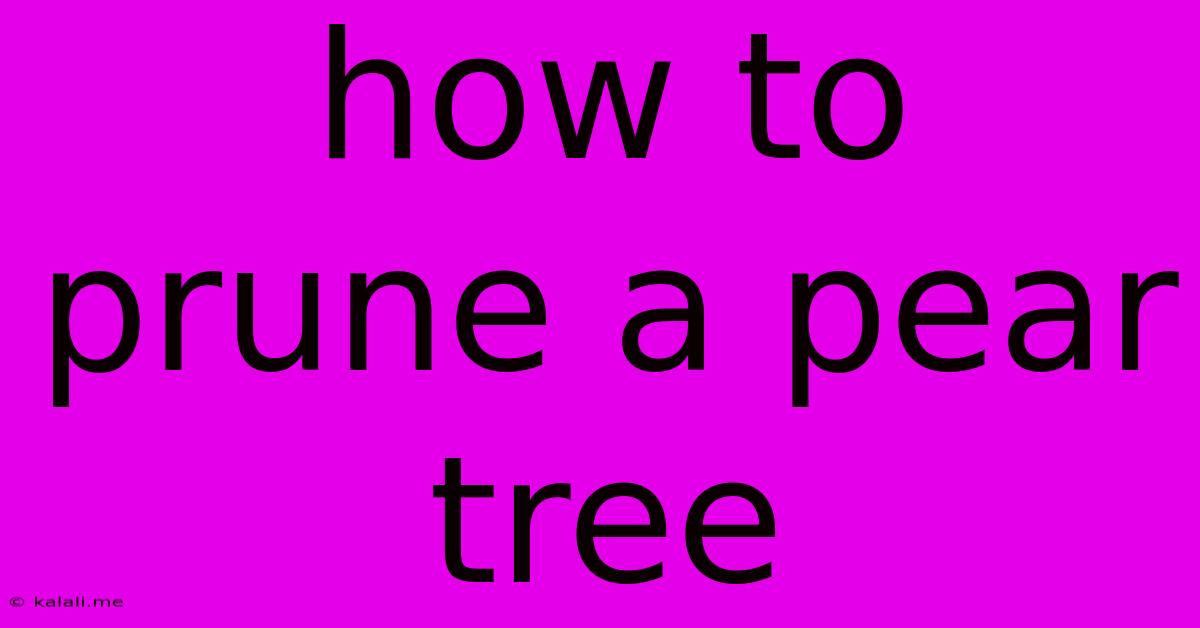How To Prune A Pear Tree
Kalali
May 24, 2025 · 4 min read

Table of Contents
How to Prune a Pear Tree: A Comprehensive Guide for Abundant Fruit
Pruning your pear tree is crucial for maintaining its health, shape, and fruit production. A well-pruned pear tree will yield more, larger, and higher-quality fruit while staying vigorous and disease-resistant. This guide covers the essential techniques and timing for effective pear tree pruning. Learn how to prune your pear tree for optimal growth and a bountiful harvest.
Understanding Pear Tree Growth Habits
Before you start pruning, it's essential to understand how pear trees grow. Unlike some fruit trees, pear trees naturally produce fruit on spurs (short, stubby branches) and older wood. Knowing this helps you focus your pruning efforts on maintaining a balance between young, growing wood and productive older wood. Different pear varieties might have slightly different growth habits, but the general principles remain the same. Understanding the tree's structure – the scaffold branches and their relationship to the central leader – will guide your pruning choices.
When to Prune a Pear Tree
The best time to prune a pear tree is during the dormant season, typically late winter or early spring, before new growth begins. This is when the tree is least stressed and the cuts will heal more quickly, minimizing the risk of disease. Avoid pruning during periods of extreme cold or when the tree is actively growing, as this can weaken it and invite disease. Summer pruning, while sometimes used for specific purposes, is generally less critical for overall tree health and productivity compared to dormant pruning.
Tools of the Trade: Essential Equipment for Pear Tree Pruning
Having the right tools makes the job easier and safer. You'll need:
- Hand pruners: For cutting small branches up to ½ inch in diameter.
- Loppers: For branches ½ to 1 ½ inches in diameter.
- Pruning saw: For branches larger than 1 ½ inches in diameter. A sharp saw makes clean cuts, crucial for preventing disease.
- Pruning sealant (optional): While not always necessary for smaller cuts, a sealant can help protect larger wounds from infection, especially on older trees.
Techniques for Pruning Pear Trees
1. Training Young Pear Trees: Young trees need shaping to establish a strong framework. This involves selecting strong scaffold branches, evenly spaced around the central leader, and removing competing or crossing branches. This early pruning promotes good air circulation and sunlight penetration, reducing the risk of disease and improving fruit production.
2. Maintaining Mature Pear Trees: Mature pear trees require less drastic pruning than young trees. The focus here shifts to removing dead, diseased, or damaged branches, thinning out crowded branches to improve light penetration, and removing suckers (water sprouts) that grow from the trunk or main branches. These suckers compete with fruit-bearing spurs for resources.
3. Thinning Fruit: While not strictly pruning, thinning fruit is a crucial aspect of pear tree management. Overcrowded fruit leads to smaller, lower-quality pears. Thinning early in the season allows remaining fruits to grow larger and develop better flavor.
4. Renewal Pruning: Older pear trees may benefit from renewal pruning, which involves removing some older wood to stimulate new growth. This technique revitalizes the tree and helps maintain fruit production. Renewal pruning usually involves selectively removing some of the oldest branches to encourage new growth from younger wood.
Common Pruning Mistakes to Avoid
- Over-pruning: Removing too much wood can stress the tree, reducing fruit production.
- Incorrect cutting techniques: Making ragged or improper cuts can leave wounds vulnerable to disease. Always make clean cuts just outside the branch collar (the slightly swollen area where the branch joins the main stem).
- Ignoring diseased or dead wood: Leaving infected branches can spread disease throughout the tree.
Maintaining Pear Tree Health Beyond Pruning
Regular pruning is a vital part of pear tree care, but it's not the only factor contributing to a healthy and productive tree. Provide adequate watering, fertilization, and pest and disease management for optimal results. Regular inspections for pests and diseases are crucial, allowing for early intervention and prevention of significant problems.
By following these steps and understanding your pear tree's growth habits, you can ensure a healthy and productive tree for years to come, yielding abundant harvests of delicious pears. Remember, patience and consistent care are key to successful pear tree pruning.
Latest Posts
Latest Posts
-
If I Can Be Of Any Help
May 24, 2025
-
Best Friend One Word Or Two
May 24, 2025
-
How To Fill In Wood Screw Holes
May 24, 2025
-
Ssh Into Raspberry Pi Over Internet
May 24, 2025
-
Do Mediums Travel Throigh High Frequecny Or Low Frequency
May 24, 2025
Related Post
Thank you for visiting our website which covers about How To Prune A Pear Tree . We hope the information provided has been useful to you. Feel free to contact us if you have any questions or need further assistance. See you next time and don't miss to bookmark.